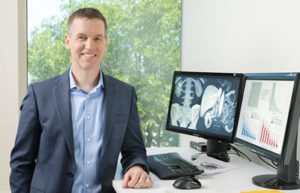
Thomas Osborne, MD
PALO ALTO, CA—The journey of Thomas Osborne, MD, into medicine was not a straight line, but it was a path that seems strangely appropriate considering his role now as Director of VA’s brand new National Center for Collaborative Healthcare Innovation.
An art student at the University of California, Santa Barbara in the mid-1990s, Osborne was recruited to the team creating the first editions of Stephen Hawking’s “Life In The Universe”—a series of CD-ROMs that allow users to visually navigate scientific concepts described by the world-renowned physicist. “That project was one of those ah-ha moments when all those pistons are firing and it resonates deeply with you,” Osborne explained. “I was able to work with animators and game designers and technologists and scientists. It’s very much the type of cross-functional work I’m doing now.”
From there he went on to medical school at Dartmouth, eventually doing a residency in radiology and later specializing in neuroradiology. “But I kept being pulled back to technology integration. I was doing a lot of informatics work, making things safer and more efficient for patient care,” Osborne said.
With the launch of the NCCHI in September, Osborne now gets to do that work on a grand scale. The center’s role is to use VA’s vast store of data to find safer, more effective and more efficient ways of caring for patients. To do that, Osborne and his colleagues must find ways to cut through the organizational silos that exist within VA and elsewhere.
“Like any organization, it can be challenging to pull the key ingredients together,” Osborne explained. “The other challenge is that VA doesn’t have all the pieces of the puzzle, especially in the form of cutting-edge technology. It became clear we need a catalyst to bring diverse people and expertise together.”
The center is that catalyst, Osborne said. Its challenge is to provide synergy within VA, other government organizations and with private industry. “The next wave of meaningful advancements will leverage the power of diverse perspectives and expertise and diverse resources,” he said.
Those advancements don’t represent technology for technology’s sake, Osborne stressed. Everything the center does moves toward the goal of finding better ways to treat injury and disease. Leveraging advanced computing, the center is sifting through VA’s patient data to better understand the risk for disease, what causes it, how to diagnose it and then to develop the best treatment options for patients.
For example, one of the center’s ongoing projects looks at three conditions—acute myocardial infarction, total knee arthroplasty and alcohol withdrawal care. By analyzing data of patients VA has treated for these conditions, Osborne hopes to identify the specific treatment options that worked best for specific types of patients.
“What happens everywhere in medicine is there are different ways to do the same thing. There are different types of hardware, different surgical approaches, different medications, different amounts of time you can spend on different things,” he explained. “We suspect that there’s probably not 100 right ways to do things but a handful of better ways. Maybe there’s a best scenario for someone who’s a certain age or a certain demographic. And another best scenario for someone who’s different. If we have multiple right ways, we can use the ones that are less expensive or take less time. More efficient care is often better care.”
What excites Osborne most about this and many other center projects is the scalability. If this analysis is successful for these three conditions, the same technique can be used on other conditions.
Another potentially scalable project is a partnership with the artificial intelligence company Deepmind on a project that uses an AI model to predict acute kidney injury up to two days before it happens. Once AKI occurs, a patient’s kidneys deteriorate quickly, so a two-day warning could be critical for physicians. Early trials have found the model to predict 56% of cases and 90% of the most serious cases. Osborne is leading a trial to determine how well the model works in a clinical setting.
“What’s compelling about this work is that the infrastructure we’re creating to make this decision support system would be applicable to other kinds of diseases. If we do this successfully, so many other diseases could be helped the same way.”
The biggest challenge for the center remains the chasms that exist between VA, other agencies and private industry. Even within VA there are divisions between teams, facilities and national programs, as well as a historical division between the IT side and the clinical side of the department.
“It speaks to the importance of a center specifically designed to be a catalyst,” Osborne said. “If we can overcome cultural and regulatory barriers, we can do really fantastic stuff.”
There has never been a time in modern memory when medical innovation was needed more, he declared. “We have three titanic forces coming together—a growing older population with multiple comorbidities, growing healthcare cost that’s unsustainable and a growing gap between the number of physicians and nurses and other caregivers and those that need them. Any one of those things would be problematic. This really had to happen.”

